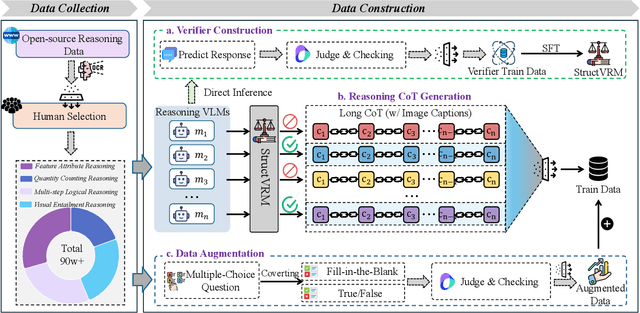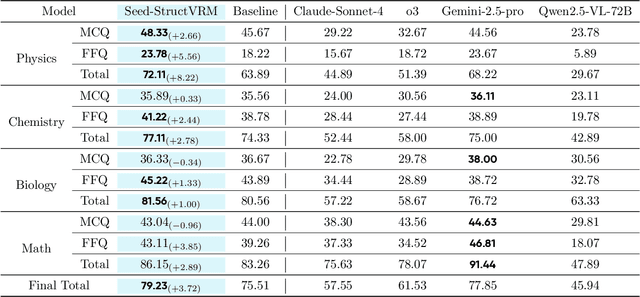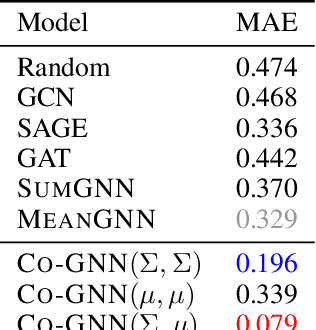Xingyue Huang
Flock: A Knowledge Graph Foundation Model via Learning on Random Walks
Oct 01, 2025Abstract:We study the problem of zero-shot link prediction on knowledge graphs (KGs), which requires models to generalize over novel entities and novel relations. Knowledge graph foundation models (KGFMs) address this task by enforcing equivariance over both nodes and relations, learning from structural properties of nodes and relations, which are then transferable to novel graphs with similar structural properties. However, the conventional notion of deterministic equivariance imposes inherent limits on the expressive power of KGFMs, preventing them from distinguishing structurally similar but semantically distinct relations. To overcome this limitation, we introduce probabilistic node-relation equivariance, which preserves equivariance in distribution while incorporating a principled randomization to break symmetries during inference. Building on this principle, we present Flock, a KGFM that iteratively samples random walks, encodes them into sequences via a recording protocol, embeds them with a sequence model, and aggregates representations of nodes and relations via learned pooling. Crucially, Flock respects probabilistic node-relation equivariance and is a universal approximator for isomorphism-invariant link-level functions over KGs. Empirically, Flock perfectly solves our new diagnostic dataset Petals where current KGFMs fail, and achieves state-of-the-art performances on entity- and relation prediction tasks on 54 KGs from diverse domains.
Of Graphs and Tables: Zero-Shot Node Classification with Tabular Foundation Models
Sep 08, 2025Abstract:Graph foundation models (GFMs) have recently emerged as a promising paradigm for achieving broad generalization across various graph data. However, existing GFMs are often trained on datasets that were shown to poorly represent real-world graphs, limiting their generalization performance. In contrast, tabular foundation models (TFMs) not only excel at classical tabular prediction tasks but have also shown strong applicability in other domains such as time series forecasting, natural language processing, and computer vision. Motivated by this, we take an alternative view to the standard perspective of GFMs and reformulate node classification as a tabular problem. Each node can be represented as a row with feature, structure, and label information as columns, enabling TFMs to directly perform zero-shot node classification via in-context learning. In this work, we introduce TabGFM, a graph foundation model framework that first converts a graph into a table via feature and structural encoders, applies multiple TFMs to diversely subsampled tables, and then aggregates their outputs through ensemble selection. Through experiments on 28 real-world datasets, TabGFM achieves consistent improvements over task-specific GNNs and state-of-the-art GFMs, highlighting the potential of tabular reformulation for scalable and generalizable graph learning.
StructVRM: Aligning Multimodal Reasoning with Structured and Verifiable Reward Models
Aug 07, 2025



Abstract:Existing Vision-Language Models often struggle with complex, multi-question reasoning tasks where partial correctness is crucial for effective learning. Traditional reward mechanisms, which provide a single binary score for an entire response, are too coarse to guide models through intricate problems with multiple sub-parts. To address this, we introduce StructVRM, a method that aligns multimodal reasoning with Structured and Verifiable Reward Models. At its core is a model-based verifier trained to provide fine-grained, sub-question-level feedback, assessing semantic and mathematical equivalence rather than relying on rigid string matching. This allows for nuanced, partial credit scoring in previously intractable problem formats. Extensive experiments demonstrate the effectiveness of StructVRM. Our trained model, Seed-StructVRM, achieves state-of-the-art performance on six out of twelve public multimodal benchmarks and our newly curated, high-difficulty STEM-Bench. The success of StructVRM validates that training with structured, verifiable rewards is a highly effective approach for advancing the capabilities of multimodal models in complex, real-world reasoning domains.
Distilling Tool Knowledge into Language Models via Back-Translated Traces
Jun 23, 2025Abstract:Large language models (LLMs) often struggle with mathematical problems that require exact computation or multi-step algebraic reasoning. Tool-integrated reasoning (TIR) offers a promising solution by leveraging external tools such as code interpreters to ensure correctness, but it introduces inference-time dependencies that hinder scalability and deployment. In this work, we propose a new paradigm for distilling tool knowledge into LLMs purely through natural language. We first construct a Solver Agent that solves math problems by interleaving planning, symbolic tool calls, and reflective reasoning. Then, using a back-translation pipeline powered by multiple LLM-based agents, we convert interleaved TIR traces into natural language reasoning traces. A Translator Agent generates explanations for individual tool calls, while a Rephrase Agent merges them into a fluent and globally coherent narrative. Empirically, we show that fine-tuning a small open-source model on these synthesized traces enables it to internalize both tool knowledge and structured reasoning patterns, yielding gains on competition-level math benchmarks without requiring tool access at inference.
HYPER: A Foundation Model for Inductive Link Prediction with Knowledge Hypergraphs
Jun 14, 2025Abstract:Inductive link prediction with knowledge hypergraphs is the task of predicting missing hyperedges involving completely novel entities (i.e., nodes unseen during training). Existing methods for inductive link prediction with knowledge hypergraphs assume a fixed relational vocabulary and, as a result, cannot generalize to knowledge hypergraphs with novel relation types (i.e., relations unseen during training). Inspired by knowledge graph foundation models, we propose HYPER as a foundation model for link prediction, which can generalize to any knowledge hypergraph, including novel entities and novel relations. Importantly, HYPER can learn and transfer across different relation types of varying arities, by encoding the entities of each hyperedge along with their respective positions in the hyperedge. To evaluate HYPER, we construct 16 new inductive datasets from existing knowledge hypergraphs, covering a diverse range of relation types of varying arities. Empirically, HYPER consistently outperforms all existing methods in both node-only and node-and-relation inductive settings, showing strong generalization to unseen, higher-arity relational structures.
How Expressive are Knowledge Graph Foundation Models?
Feb 18, 2025Abstract:Knowledge Graph Foundation Models (KGFMs) are at the frontier for deep learning on knowledge graphs (KGs), as they can generalize to completely novel knowledge graphs with different relational vocabularies. Despite their empirical success, our theoretical understanding of KGFMs remains very limited. In this paper, we conduct a rigorous study of the expressive power of KGFMs. Specifically, we show that the expressive power of KGFMs directly depends on the motifs that are used to learn the relation representations. We then observe that the most typical motifs used in the existing literature are binary, as the representations are learned based on how pairs of relations interact, which limits the model's expressiveness. As part of our study, we design more expressive KGFMs using richer motifs, which necessitate learning relation representations based on, e.g., how triples of relations interact with each other. Finally, we empirically validate our theoretical findings, showing that the use of richer motifs results in better performance on a wide range of datasets drawn from different domains.
Theoretical Insights into Line Graph Transformation on Graph Learning
Oct 21, 2024Abstract:Line graph transformation has been widely studied in graph theory, where each node in a line graph corresponds to an edge in the original graph. This has inspired a series of graph neural networks (GNNs) applied to transformed line graphs, which have proven effective in various graph representation learning tasks. However, there is limited theoretical study on how line graph transformation affects the expressivity of GNN models. In this study, we focus on two types of graphs known to be challenging to the Weisfeiler-Leman (WL) tests: Cai-F\"urer-Immerman (CFI) graphs and strongly regular graphs, and show that applying line graph transformation helps exclude these challenging graph properties, thus potentially assist WL tests in distinguishing these graphs. We empirically validate our findings by conducting a series of experiments that compare the accuracy and efficiency of graph isomorphism tests and GNNs on both line-transformed and original graphs across these graph structure types.
One Model, Any Conjunctive Query: Graph Neural Networks for Answering Complex Queries over Knowledge Graphs
Sep 21, 2024



Abstract:Traditional query answering over knowledge graphs -- or broadly over relational data -- is one of the most fundamental problems in data management. Motivated by the incompleteness of modern knowledge graphs, a new setup for query answering has emerged, where the goal is to predict answers that do not necessarily appear in the knowledge graph, but are present in its completion. In this work, we propose AnyCQ, a graph neural network model that can classify answers to any conjunctive query on any knowledge graph, following training. At the core of our framework lies a graph neural network model trained using a reinforcement learning objective to answer Boolean queries. Our approach and problem setup differ from existing query answering studies in multiple dimensions. First, we focus on the problem of query answer classification: given a query and a set of possible answers, classify these proposals as true or false relative to the complete knowledge graph. Second, we study the problem of query answer retrieval: given a query, retrieve an answer to the query relative to the complete knowledge graph or decide that no correct solutions exist. Trained on simple, small instances, AnyCQ can generalize to large queries of arbitrary structure, reliably classifying and retrieving answers to samples where existing approaches fail, which is empirically validated on new and challenging benchmarks. Furthermore, we demonstrate that our AnyCQ models effectively transfer to out-of-distribution knowledge graphs, when equipped with a relevant link predictor, highlighting their potential to serve as a general engine for query answering.
Link Prediction with Relational Hypergraphs
Feb 06, 2024Abstract:Link prediction with knowledge graphs has been thoroughly studied in graph machine learning, leading to a rich landscape of graph neural network architectures with successful applications. Nonetheless, it remains challenging to transfer the success of these architectures to link prediction with relational hypergraphs. The presence of relational hyperedges makes link prediction a task between $k$ nodes for varying choices of $k$, which is substantially harder than link prediction with knowledge graphs, where every relation is binary ($k=2$). In this paper, we propose two frameworks for link prediction with relational hypergraphs and conduct a thorough analysis of the expressive power of the resulting model architectures via corresponding relational Weisfeiler-Leman algorithms, and also via some natural logical formalisms. Through extensive empirical analysis, we validate the power of the proposed model architectures on various relational hypergraph benchmarks. The resulting model architectures substantially outperform every baseline for inductive link prediction, and lead to state-of-the-art results for transductive link prediction. Our study therefore unlocks applications of graph neural networks to fully relational structures.
Cooperative Graph Neural Networks
Oct 02, 2023



Abstract:Graph neural networks are popular architectures for graph machine learning, based on iterative computation of node representations of an input graph through a series of invariant transformations. A large class of graph neural networks follow a standard message-passing paradigm: at every layer, each node state is updated based on an aggregate of messages from its neighborhood. In this work, we propose a novel framework for training graph neural networks, where every node is viewed as a player that can choose to either 'listen', 'broadcast', 'listen and broadcast', or to 'isolate'. The standard message propagation scheme can then be viewed as a special case of this framework where every node 'listens and broadcasts' to all neighbors. Our approach offers a more flexible and dynamic message-passing paradigm, where each node can determine its own strategy based on their state, effectively exploring the graph topology while learning. We provide a theoretical analysis of the new message-passing scheme which is further supported by an extensive empirical analysis on a synthetic dataset and on real-world datasets.
 Add to Chrome
Add to Chrome Add to Firefox
Add to Firefox Add to Edge
Add to Edge